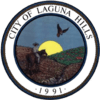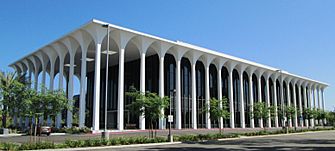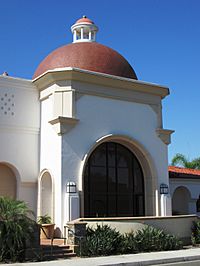Laguna Hills, California facts for kids
Quick facts for kids
Laguna Hills, California
|
||
|---|---|---|
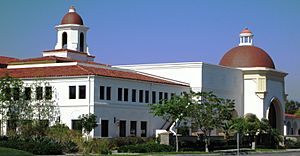
Laguna Hills Civic Center from west
|
||
|
||
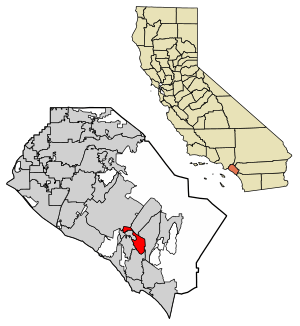
Location of Laguna Hills in Orange County, California.
|
||
| Country | United States | |
| State | California | |
| County | Orange | |
| Incorporated | December 20, 1991 | |
| Government | ||
| • Type | Council-Manager | |
| Area | ||
| • Total | 6.57 sq mi (17.02 km2) | |
| • Land | 6.55 sq mi (16.96 km2) | |
| • Water | 0.03 sq mi (0.06 km2) 0.37% | |
| Elevation | 364 ft (111 m) | |
| Population
(2020)
|
||
| • Total | 31,374 | |
| • Density | 4,775/sq mi (1,843.4/km2) | |
| Time zone | UTC−8 (Pacific) | |
| • Summer (DST) | UTC−7 (PDT) | |
| ZIP Codes |
92637, 92653–92654, 92656
|
|
| Area code | 949 | |
| FIPS code | 06-39220 | |
| GNIS feature ID | 1667917 | |
Laguna Hills is a city in southern Orange County, California, United States. Its name comes from the Spanish word laguna, meaning lagoon. The city is close to Laguna Canyon and the older Laguna Beach. Other nearby cities like Laguna Niguel and Laguna Woods also share a similar name. In 2020, about 31,374 people lived here.
Contents
Geography
Laguna Hills covers about 6.7 square miles (17.02 square kilometers). Most of this area is land, with a very small part being water.
History
Laguna Hills is built on land that was once part of large ranches. These ranches were huge pieces of land given out after Mexico became independent from Spain in 1821. They were used for raising cattle.
One of these ranches was called Rancho Niguel. Don Juan Avila was given this 13,000-acre ranch, which included the area where Laguna Hills is today. Later, in 1894, a man named Lewis Moulton bought Rancho Niguel. He made the ranch even bigger, to about 22,000 acres. Moulton and his partner used the land to raise sheep and cattle.
In the early 1960s, the Moulton Ranch was divided into smaller pieces. One of these pieces became modern-day Laguna Hills. People living in the area decided they wanted to form their own city. In 1991, 86% of residents voted to become a city. On December 20, 1991, Laguna Hills officially became a city. Over the years, the city grew by adding nearby areas.
In 2004, the City Hall moved to a new building. The city bought and updated an office building on El Toro Road. The city uses part of the building and rents out other parts to businesses. This helps the city earn money.
Transportation
Roads
![]() Interstate 5 is a major highway that runs along the eastern edge of Laguna Hills. It forms the border with Lake Forest and Mission Viejo. You can get on or off I-5 at five different exits within the city.
Interstate 5 is a major highway that runs along the eastern edge of Laguna Hills. It forms the border with Lake Forest and Mission Viejo. You can get on or off I-5 at five different exits within the city.
![]() County Route S18, also known as El Toro Road, is another important road in Laguna Hills. It stretches from the I-5 freeway to the 73 Toll Road.
County Route S18, also known as El Toro Road, is another important road in Laguna Hills. It stretches from the I-5 freeway to the 73 Toll Road.
Other main roads in the city include Alicia Parkway, Oso Parkway, and Moulton Parkway. These roads help people travel easily throughout Laguna Hills and to neighboring cities.
Demographics
| Historical population | |||
|---|---|---|---|
| Census | Pop. | %± | |
| 1970 | 13,676 | — | |
| 1980 | 33,600 | 145.7% | |
| 1990 | 46,731 | 39.1% | |
| 2000 | 31,178 | −33.3% | |
| 2010 | 30,344 | −2.7% | |
| 2020 | 31,374 | 3.4% | |
| U.S. Decennial Census 1860–1870 1880-1890 1900 1910 1920 1930 1940 1950 1960 1970 1980 1990 2000 2010 2020 |
|||
Laguna Hills first appeared in the U.S. Census in 1970. It was officially listed as a city in the 2000 Census after it became incorporated.
2020 Census Information
In 2020, Laguna Hills had a population of 31,374 people. The city is home to a diverse group of residents. About 53.7% of the population was White (not Hispanic), 15.03% was Asian, and 1.34% was Black or African American. People of Hispanic or Latino background made up about 23.87% of the population.
2010 Census Information
In 2010, the population of Laguna Hills was 30,344. Most people lived in homes, while a small number lived in group housing or institutions.
There were 10,469 households in the city. About 34.7% of these households had children under 18 living in them. Most households (60%) were married couples. The average household had about 2.86 people.
The age of people in Laguna Hills varied:
- 22.3% were under 18 years old.
- 8.6% were between 18 and 24.
- 25.2% were between 25 and 44.
- 31.1% were between 45 and 64.
- 12.8% were 65 years or older.
The average age in the city was 40.8 years.
2000 Census Information
In 2000, Laguna Hills had 31,178 residents. There were 10,895 households. About 37.5% of these households had children under 18. The average household size was 2.82 people.
About 26.2% of the population was under 18 years old. The median age was 38 years.
Government
Laguna Hills is run by a Council-Manager type of government. This means there is a City Council that makes decisions, and a City Manager who handles the day-to-day operations of the city. The mayor, Dave Wheeler, leads the City Council.
Historically, Laguna Hills has mostly voted for Republican candidates in presidential elections. However, in the 2020 election, Joe Biden became the first Democratic presidential candidate to win the city since it became incorporated.
Laguna Hills is represented in both the California State Legislature and the United States House of Representatives.
The Laguna Hills Civic Center, where the City Hall is located, was an existing office building that the city bought and updated in 2004. The city uses part of the building for its offices and rents out the rest to businesses. This helps the city make money.
Laguna Hills is also home to one of the California DMV offices. This office provides services like driving tests and helps people with vehicle registration. It serves many people in southern Orange County.
Emergency services
The Orange County Fire Authority provides fire protection for Laguna Hills. Care Ambulance Service handles ambulance calls. The city also has a hospital, MemorialCare Saddleback Medical Center, which has an emergency room. Law enforcement is handled by the Orange County Sheriff's Department.
Economy
Some important places for business in Laguna Hills include:
- The former Laguna Hills Mall, which closed in 2018. It is being redeveloped into a new area called Five Lagunas with different types of buildings.
- The area around El Toro Road and the I-5 freeway. This area is very busy with cars and travelers, so it has many shopping centers and fast-food restaurants.
Education
Students in Laguna Hills attend schools within the Saddleback Valley Unified School District. There are several elementary schools, including Lomarena, San Joaquin, and Valencia Elementary Schools. Middle school students attend La Paz Intermediate School or Los Alisos Intermediate School, which is in nearby Mission Viejo.
Laguna Hills has its own high school, Laguna Hills High School. It was built in 1978 and is one of the smaller high schools in the area, with fewer than 1,700 students. Laguna Hills High School has been recognized as a National Blue Ribbon School and a California Distinguished School many times.
Notable people
- Shane Bieber, a major league baseball pitcher for the Cleveland Indians. He was the MVP of the 2019 Major League Baseball All-Star Game and won the Cy Young Award in 2020.
- Aloe Blacc, a singer and songwriter famous for his song "I Need A Dollar".
- Chad Carvin (born 1974), an Olympic medalist swimmer.
- Phil Collen (current resident), the guitarist for the band Def Leppard.
- Russ Conway, an actor.
- Fieldy (current resident), the bass guitarist for the band Korn.
- Steve Gibson, a computer programmer and co-host of Security Now.
- Mike Hopkins, a basketball coach and former player for Syracuse Orange men's basketball.
- Jeff Keane, the cartoonist for Family Circus.
- Tyler Krieger (born 1994), a baseball player in the Cleveland Indians organization.
- John Lamb, a major league baseball pitcher for the Cincinnati Reds.
- Michael Novales (born 1985), a former US figure skating competitor, now skating for the Philippine Skating Union.
- Carson Palmer (born 1998), an NFL quarterback and Heisman Trophy winner from the University of Southern California.
- Kaitlin Sandeno (born 1983), an Olympic medalist swimmer.
- George Sixta, a cartoonist known for Rivets.
- Reece Ushijima (born 2003), a Japanese-American racing driver.
- Zacky Vengeance (current resident), the rhythm guitarist for the band Avenged Sevenfold.
See also
 In Spanish: Laguna Hills para niños
In Spanish: Laguna Hills para niños


